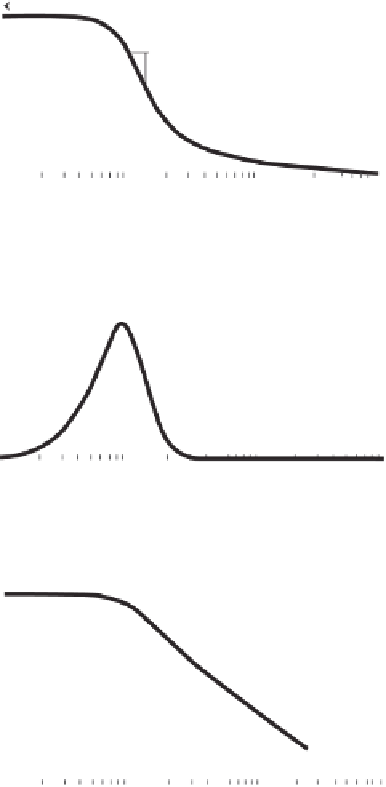Environmental Engineering Reference
In-Depth Information
where the negative pore-water pressures are maintained. The
numerical study conducted by Sun et al. (1998) showed that
the transition zone is less distinct when the new infiltration
rate is quite small (Fig. 8.72).
Matric suction in an unsaturated soil may not be destroyed
even under long periods of rainfall infiltration. Kasim et al.,
(1998a) studied the relationship between steady-state rain-
fall, the permeability function, and the SWCC on equilib-
rium matric suction conditions. The study was carried out for
both horizontal ground surfaces and sloping ground surfaces.
Results of the analysis showed that steady-state rainfall does
not necessarily eliminate matric suctions in the soil. The
long-term matric suction in the soil is largely maintained
when the steady-state rainfall is one or more orders of mag-
nitude less than the saturated coefficient of permeability.
It appears that matric suction will not disappear unless the
steady-state rainfall flux approaches the saturated coefficient
of permeability of the soil near the ground surface.
There are two soil properties that need to be taken into
consideration when analyzing the infiltration of water into
an unsaturated soil. These two properties are the permeabil-
ity function and the water storage function. Both of these
properties bear a relationship to the SWCC as shown in
Fig. 8.73. Steady-state seepage conditions can be analyzed
by giving consideration to the permeability function. How-
ever, both the permeability function and the water storage
function need to be taken into consideration when analyzing
transient seepage.
a
0.50
0.40
0.30
n
0.20
0.10
0.00
0.1
10
1000
100,000
Soil suction (kPa)
0.020
0.015
0.010
0.005
0.000
0.1
10
1000
100,000
Soil suction (kPa)
1.0E-04
1.0E-06
1.0E-08
1.0E-10
1.0E-12
1.0E-14
8.4.1 Infiltration during Rainfall
The infiltration and the seepage of water through an
unsaturated soil can be analyzed through use of saturated-
unsaturated seepage modeling. The results of numerical
studies, however, can be difficult to interpret because several
variables are involved. The primary soil parameters are the
coefficient of permeability function, water storage function,
rainfall intensity, and rainfall duration. The unsaturated
soil properties are related to the SWCC. The fundamental
processes associated with infiltration under both steady-state
and unsteady-state conditions need to be considered sepa-
rately in order to interpret results from a numerical analysis.
Kisch (1959) derived an equation for one-dimensional
steady-state seepage into a soil subjected to a constant water
flux
q
at the ground surface. The magnitude of the water
flux,
q
, was calculated for a vertical soil column of unit
cross-sectional area:
1.0E-16
0.1
10
1000
100,000
Soil suction kPa)
Figure 8.73
Relationship between the SWCC, water storage
function and permeability function for an unsaturated soil.
If the magnitude of the ground surface flux,
q
,isin
the unsaturated coefficient of permeability range for a soil,
k
w
, the pore-water pressure head gradient
d
u
w
/ρ
w
g
/dy
becomes zero [i.e., pressure head
u
w
/
ρ
w
g
tends toward a
constant].
Figure 8.74 shows steady-state pressure head profiles in a
clay liner and an underlying sand layer published by Kisch
(1959). The surface water flux
q
was equal to the saturated
coefficient of permeability of the clay liner,
k
s,
clay
.Thesat-
urated coefficient of permeability of the sand,
k
s,
sand
,was
140 times
k
s,
clay
. The thickness of the clay liner was 0.5 m.
The water table was at depths of 2.5 and 4.5 m for cases I
and II, respectively.
The gradient of pressure head is zero at the upper por-
tion of the sand layer under both steady-state cases. The
pore-water pressures at the top of the sand remain at a con-
stant value of
k
w
1
du
w
ρ
w
g
dy
q
=
+
(8.60)
The moisture flux
q
is constant under steady-state condi-
tions and Eq. 8.60 can be written as
d
u
w
/ρ
w
g
dy
q
k
w
−
1
=
(8.61)
−
5.5 kPa when the ground surface flux
q













Search WWH ::

Custom Search